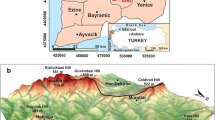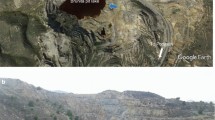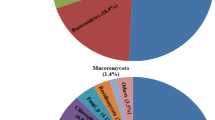Abstract
We examine the origin of acid mine drainage (AMD) that forms within coal refuse (gob) piles at the Green Valley and Friar Tuck sites in Indiana, using microbiology, traditional geochemistry, and oxygen and hydrogen isotopes. Reducing the AMD load from these sites has been an historical priority. Our observations indicate that AMD generation at these sites in Indiana is driven by three complementary factors: elevated populations of chemolithotrophic microbes of the species Acidithiobacillus ferrooxidans; a growth substrate that provides ‘food’ (e.g. pyrite) for these microbes, and a gob pile with geometry and other properties conducive to maintaining the thermal window of 25–40°C for optimal A. ferrooxidans growth. In particular, increasing levels of Fe+3 and total dissolved solids (TDS), and decreasing pH for gob waters were found to be highly correlated with increasing populations of A. ferrooxidans. Furthermore, the chemosythetic bacteria population increase correlates with increasing hydrogen stable isotope shift away from the global meteoric water line for gob waters in this study, though it is unclear if this shift is the result of microbial metabolic processes or a secondary effect due to microbially-mediated pH change or electrolysis.








Similar content being viewed by others
References
Allen DM, Voormeij DA (2002) Oxygen-18 and deuterium fingerprinting of tailings seepage at the Sullivan Mine. B.C. Mine Water Environ 21:168–182
Amt E, Houston C, Turner A, Jerz JK, Gourley BL (2003) West Little Sugar Creek is recovering but still impacted by acid drainage from the abandoned Green Valley Mine in Southwest Indiana. In: Proceedings of Geological Society of America Abstracts, Nov 2–5, p 123
Brake SS, Connors K, Romberger S (2001a) A river runs through it: impact of acid mine drainage on the geochemistry of West Little Sugar Creek pre- and post-reclamation at the Green Valley coal mine, Indiana, USA. Environ Geol 40:1471–1481
Brake SS, Dannelly HK, Connors K, Hasiotis ST (2001b) Influence of water chemistry on the distribution of an acidophilic protozoan in an acid mine drainage system at the abandoned Green Valley coal mine, Indiana, USA. Appl Geochem 16:1641–1652
Brake SS, Hasiotis ST, Rogers JR (2003) Microstructures and microorganisms in the macrofabric of iron stromatolites, Green Valley Mine, Indiana. Proceedings of Geological Society of America Annual Meeting, abstracts, Seattle, Washington, USA, vol 34, p 150
Branam TD, Harper D (1994) Tabulated analytical data for water samples from the Friar Tuck site. Indiana Geological Survey Open-File Study 94-13
Brett J, Baker BJ, Banfield JF (2003) Microbial communities in acid mine drainage. FEMS Microbiol Ecol 40:139–152
Caserotti PM, Marland G (1973) Impact of coal mine-waste runoff on a small stream. Proc Indiana Acad Sci 83:239–240
Clark DA, Norris PR (1996) Acidimicrobium ferrooxidans gen. nov., sp. nov.: mixed-culture ferrous iron oxidation with Sulfobacillus species. Microbiology 142:785–790
Coleman ML, Shepard TJ, Rouse JE, Moore GR (1982) Reduction of water with zinc for hydrogen isotope analysis. Anal Chem 54:993–995
Craig H (1961) Isotopic variations in meteoric waters. Science 133:1702–1703
Dale D (2001) Unpubl report, IN Dept of natural resources, Div of reclamation, Jasonville, IN, USA
Eggert DL, Hailer JG, Irwin PN, Miller LV (1981) Energy content, composition, and associated water chemistry of wastes in the coal-preparation plant of the Green Valley-Wabash mine, Vigo County, Indiana. Proc, Symp Surface Mining Hydrology and Reclamation, Univ of Kentucky, Dec. 7–11, pp 143–149
Epstein S, Mayeda T (1953) Variation of 18O content of waters from natural sources. Geochim Cosmochim Acta 4:213–224
Ferroni GD, Leduc LG, Todd M (1986) Isolation and temperature characterization of psychrotrophic strains of Thiobacillus ferrooxidans from the environment of a unranium mine. J Gen Appl Microbiol 32:169–175
Flege AE (2001) Sulfate reduction in five constructed wetlands receiving acid mine drainage. MS thesis, Univ of Cincinnati, OH, USA
Geosciences Research Associates (1985) Feasibility study for the reclamation of the Green Valley Mine Site. Project Report # E23-210: 94
Harper D, Hartke EJ, West T, Olyphant G (1988) Research and reclamation feasibility studies at the Friar Tuck site: 1st annual report to the Indiana Div of Reclamation, unpubl report, Jasonville, IN, USA
Harper D, Hartke EJ, Olpyhant G, West T (1989) Research and reclamation feasibility studies at the Friar Tuck site: second annual report to the Indiana Division of Reclamation, Part A—chemical analyses and hydrologic investigations, unpubl report, Jasonville, IN, USA
Harper D, Olyphant GA, Hartke EJ, Branam TD (1993) Direct revegetation of abandoned coal-refuse deposits in Indiana: its effects on hydrology, chemistry, and erosion: Indiana Geological Survey Open-File Study 93-09, Bloomington, IN, USA
Hazen JM, Williams MW, Stover B, Wireman M (2002) Acid mine drainage characterization and remediation using a combination of hydrometric, chemical, and isotopic analyses, Mary Murphy Mine, Colorado. Environ Geochem Hlth 24:1–22
Hunkeler D, Andersen N, Aravena R, Bernasconi SM, Butler BJ (2001) Hydrogen and carbon isotope fractionation during aerobic biodegradation of benzene. Environ Sci Technol 35:3462–3467
Kelly DP, Wood AP (2000) Reclassification of some species of Thiobacillus to the newly designated genera Acidithiobacillus gen. nov., Halothiobacillus gen. nov. and Thermithiobacillus gen. nov. Int Jour Syst Evol Microbiol 50:489–500
Kuenen JG, Robertson LA, Tuovinen OH (1992) The genera Thiobacillus, Thiomicrospira, and Thiosphaera. In: Balows A, Trüper HG, Dworkin M, Harder H, Schleifer KH (eds) The prokaryotes, Ch 138, vol 3, 2nd edn. Springer, Berlin, Germany, pp 2636–2657
Melchiorre EB, Mills JG Jr, Dale DA, Chapman B (2004) A new occurrence of Xitieshanite (Fe3+(SO4)Cl·6H2O) in acid-mine seepways, Vigo County, Indiana, USA. Am Mineralogist 90:1518–1521
Melchiorre EB, Dale DA, Mills JG Jr, Chapman B (2005) Geochemical and stable isotope evidence for precipitation and groundwater sourcing of recharge at the Green Valley Site, Vigo County, Indiana. Mine Water Environ 24:88–100
Morasch B, Richnow HH, Schink B, Meckenstock RU (2001) Stable hydrogen and carbon isotope fractionation during microbial toluene degradation: mechanistic and environmental aspects. Appl Environ Microbiol 67:4842–4849
Morasch B, Richnow HH, Schink B, Vieth A, Meckenstock RU (2002) Carbon and hydrogen stable isotope fractionation during aerobic bacterial degradation of aromatic hydrocarbons. Appl Environ Microbiol 68:5191–5194
Rawlings DE, Tributsch H, Tributsch GS (1999) Reasons why ‘Leptospirillum’-like species rather than Thiobacillus ferrooxidans are the dominant iron-oxidizing bacteria in many commercial processes for the biooxidation of pyrite and related ores. Microbiology 145:5–13
Robertson LA, Kuenen JG (2005) The genus Thiobacillus- Prokaryotes. Release 3.9. accessed 7/25/05, http://141.150.157.117:8080/prokPUB/chaprender/jsp/showchap.jsp?chapnum=383&initsec=01_00
Rose AW, Cravotta CA (1998) Geochemistry of coal mine drainage. In: Brady KC, Smith MW, Schueck J (eds) Coal mine drainage prediction and pollution prevention in Pennsylvania, Pa Dept of Environmental Protection, Harrisburg, PA, USA, Ch 3, p 1-1-1-22
Schrenk MO, Edwards KJ, Goodman RM, Hamers RJ, Banfield JF (1998) Distribution of Thiobacillus ferrooxidans and Leptospirillum ferrooxidans: implications for generation of acid mine drainage. Science 279:1519–1522
Silverman MP, Lundgren DG (1958) Studies on the chemoautotrophic iron bacterium Ferrobacillus ferrooxidans: an improved medium and a harvesting procedure for securing high cell yields. J Bact 77:642
Unger DL, Brake SS, Mattox JM, Wolf SF, Hasiotis ST (2003) Investigation of water chemistry and precipitate composition in an acid mine drainage system at the Green Valley coal mine site. Proc, Geological Soc of America Annual Meeting (abstracts, Seattle, Washington, USA, vol 34, p 123)
Valentine DL, Chidthaisong A, Rice A, Reeburgh WS, Tyler SC (2004) Carbon and hydrogen isotope fractionation by moderately thermophilic methanogens. Geochim Cosmochim Acta 68:1571–1590
Acknowledgments
First, and foremost, I thank Dr. Jim Mills of DePauw University, and Deb Dale of the US Office of Surface Mining for introducing me to the two field locations and thier many valuable discussions. I thank the owner of the Green Valley site and the IDNR for permission to access the properties. The IDNR facilitated access and provided professional expertise on AMD issues. I thank Tracy D. Branam of the Indiana Geological Survey for many valuable discussions on the geochemistry of AMD in Indiana. Jessica Cancilla and Brandon Chapman, students at DePauw University, assisted with water sampling. Drs. Bill and Carolyn Baldwin provided additional field support and historical information on life at the Green Valley site during the period of mining operations. This work was funded by a grant from the Indiana Division of Reclamation, Surface Mining and Reclamation Technology program. Support for mass spectrometry and EDS instrumentation and analyses were provided by the National Science Foundation, EAR-0115884 and EAR-0941106. Acknowledgment is made to the donors of the American Chemical Society Petroleum Research Fund for partial support of this research on some carbonates and pore fluid migration modeling.
Author information
Authors and Affiliations
Corresponding author
Rights and permissions
About this article
Cite this article
Melchiorre, E. Microbiological Evidence for the Origin of Acid Mine Drainage at the Green Valley Site, Vigo County, and Friar Tuck Site, Greene County, Indiana, USA. Mine Water Environ 30, 175–184 (2011). https://doi.org/10.1007/s10230-011-0141-9
Received:
Accepted:
Published:
Issue Date:
DOI: https://doi.org/10.1007/s10230-011-0141-9




